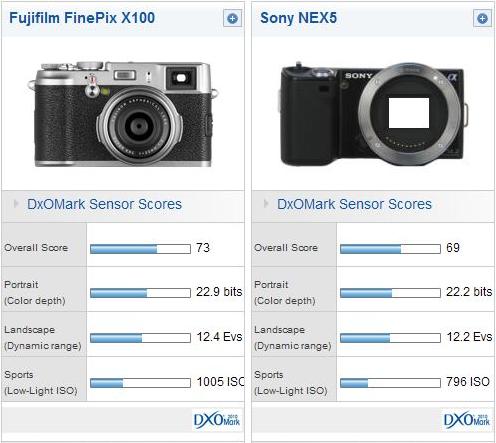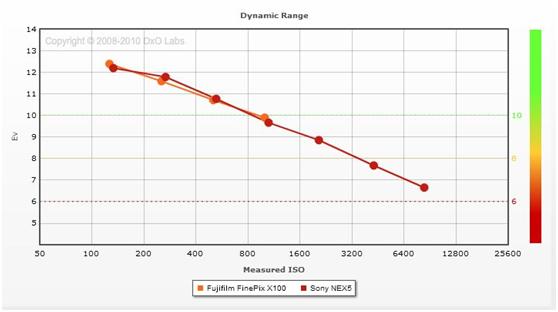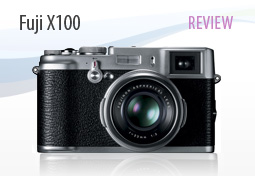Introduction
Meet the NEX-5, with its impressive score in our comparison database this model is among the most popular mirrorless cameras today. This time around though, it has a worthy rival that might challenge its place, reading our overall final scores could be enough to prove it.
In the final score the X100 shows a 4 point advantage over the NEX-5, it outperforms Sony’s camera in all the tested fields (Portrait and Landscape).
Outstanding Sports (Low light ISO) Results
This is the test field where the X100 is noticeably better than the NEX-5:
With a 1005 ISO which is 1/3 EV better than the NEX-5 we obtain a remarkably good performance.
Let us remember that in this very field the NEX-5 had a clear advantage over micro 4/3.
This makes the X100 the best mirrorless in terms of low-light performance.

On the SNR metrics arena, the results are good and they give a slight advantage to the X100, but in this case the gap between the two cameras is narrow.
Better Dynamic Range But Not By Much
In this field the two cameras behave very closely and trying to find a clear distinction is not easy. At ISO 200 however, the NEX-5 has a tiny advantage over the X100. Globally speaking, we can say both sensors behave similarly.

Color Sensitivity
The main differences are in the tonal range and color sensitivity metrics, for which the X100 is always ahead, sometimes by 2/3 EV, as is the case at ISO 1600.
The metrics are clear: the NEX-5 was a great performer, but the X100 is at least as good, and often a bit better. Less noise, better color performance, and much better high ISO behavior make the difference.
It performs as well as the Nikon D90 and better than the Canon EOS 60D
Compared to meatier DSLRs, the X100 surprisingly stands its ground. Its Overall score places it at the level of a Nikon D90 and a bit above an EOS 60D. According to our tests the X100 is superior to the EOS 60D in all the DXO Mark case scores and it performs equally as well as the D90, except in the Sports score where it does slightly better.
The detailed metrics confirm our previous statements, the SNR is almost identical for the D90, the EOS 60D, and the X100.
Nevertheless the D90 still has a clear advantage in the dynamic range; on the other hand in lower ISO settings the X100 is superior to the 60D.
Before concluding this review, let’s spend a few lines explaining the ISO sensitivity graph, on which a selected ISO 1600 corresponds to a simple ISO 1000. This measured ISO remains constant for selected ISOs 3200 and 6400.
On the surface this is odd, but perfectly explainable:
A manufacturer has two options for increasing ISO sensitivity; either to order the sensor to increase its analog sensitivity, or after a picture is taken to tell the camera to amplify the image signal via algorithms at the RAW conversion stage.
Fujifilm decided to implement the second choice with the X100 and this processing action is normally invisible to the user.
As long as the algorithms used for the treatment are performing well, there is no real problem for the end user. As far as RAW measurements are concerned, the sensor’s maximum sensitivity is ISO 1000. That’s why none of our metrics goes further.
The X100 really has impressive metrics for a compact camera. Its sensor manages to outperform that of the Sony NEX-5, and thus takes first place in the mirrorless rankings. The interesting part though is that it also manages to outperform or rival mid-range DSLRs such as the Nikon D90 and the Canon EOS 60D, thanks to its well-handled noise and good color management, but above all thanks to a truly decent low-light performance.
Previously Sony’s NEX-5 had already threatened some DSLRs in performance quality, and we now know for sure the X100 goes even further.
It remains to be seen if the X100’s sensor performance can help it overcome other negative points in categories such as: video function, fixed v. interchangeable lenses, and overall speed.
On a side note let us not forget that no matter how good the X100 might be, the latest generation of Sony 16 Mpx sensors that powers models such as the K5, the Alpha 580, and the D7000 is still far better; especially where dynamic range is concerned. On the other hand, these models are still far more expensive.
If we take only sensor performance into account, the X100 is a success and we’ll even go as far as to declare it the perfect everyday companion for the DSLR enthusiast.





DXOMARK encourages its readers to share comments on the articles. To read or post comments, Disqus cookies are required. Change your Cookies Preferences and read more about our Comment Policy.